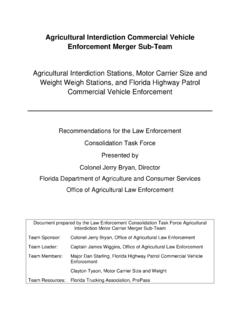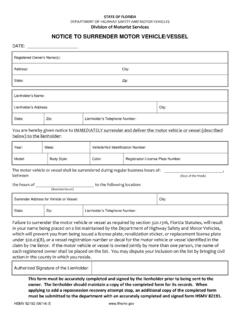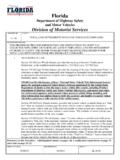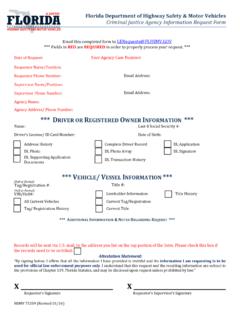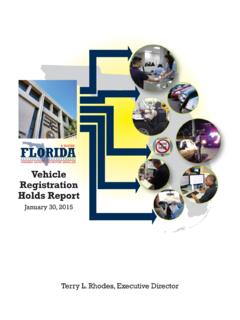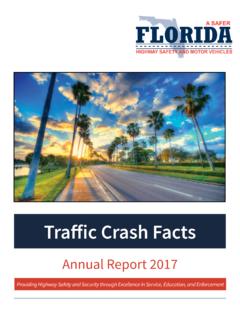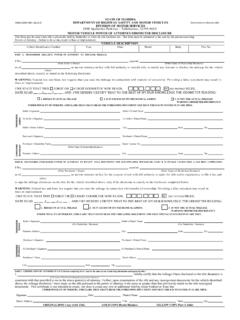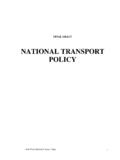Transcription of State of Florida Aviation Assets - Florida Highway …
1 LAW ENFORCEMENT CONSOLIDATION TASK FORCE State Aviation CONSOLIDATION SUB-TEAM State of Florida Aviation Assets Recommendations for the Law Enforcement Consolidation Task Force presented by Colonel Jerry Bryan, Director Department of Agriculture and Consumer Services Office of Agricultural Law Enforcement 11/4/2011 Document prepared by the Law Enforcement Consolidation Task Force State Aviation Consolidation Sub-Team Team Sponsor: Colonel Jerry Bryan Department of Agriculture and Consumer Services Office of Agricultural Law Enforcement Team Leader: Mr. Brian McKee, Aviation Manager Department of Agriculture and Consumer Services Florida Forest Service Team Members: Lieutenant Colonel Calvin Adams, Florida Fish and Wildlife Conservation Commission (FWC) Special Agent Supervisor Rick Ward, Florida Department of Law Enforcement (FDLE) Captain Matt Walker, Department of Highway Safety and Motor Vehicles Florida Highway Patrol (FHP) Mr.
2 Tim Lattner, Florida Department of Transportation (FDOT) Captain Kevin Vislocky, (FWC), Representing the Division of Emergency Management, Air Operations Coordination Captain Tim Riordan, Florida Fish and Wildlife Conservation Commission (FWC) Special Agent Tim Cannon, Florida Department of Law Enforcement (FDLE) 2 Contents Overview .. 3 Background Information .. 5 Chart 1: State of Florida Agency Aircraft Comparison 2000 2011 .. 5 Integration of Law Enforcement Aviation Florida Department of Transportation Aerial Mapping Florida Forest Service Fire Program .. 7 Multi-Agency Aircraft Use - SEOC Air Operations Coordinator .. 8 Managers Group .. 9 Aviation Facilities .. 10 Aircraft Fuel .. 11 Maintenance .. 12 Aerial Ignition .. 13 APPENDIX A: State Agency Aviation Unit Missions .. 144 Florida Fish and Wildlife Conservation Commission (FWC).
3 144 Florida Highway Patrol (FHP) .. 144 Florida Forest Service (FFS) .. 15 Florida Department of Transportation (FDOT) .. 15 Florida Department of Law Enforcement (FDLE) .. 15 Appendix B: State of Florida Agency Aircraft Comparison 2000 17 3 Overview Five State -owned Aviation units currently operate airplanes and helicopters in Florida . The Florida Department of Law Enforcement (FDLE), Florida Highway Patrol (FHP) and the Florida Fish and Wildlife Conservation Commission (FWC) use aircraft for law enforcement purposes, the Florida Department of Transportation (FDOT) for aerial mapping, and the Florida Forest Service (FFS) for fire protection. Airplanes and helicopters are powerful tools used to carry out the missions of these respective agencies. These aircraft are piloted by sworn law enforcement officers or certified fire fighters1 There is a long history of cooperation between the Aviation programs.
4 Safe, effective, efficient and appropriate aircraft use is a goal of all the agencies operating aircraft. Continuous improvement has been inherent in Aviation since its beginning and is evident in each of these programs. A look back at the changes in these State Aviation programs over time reveals their ability to initiate process changes to accommodate new or evolving missions, technology, organizational structures and constantly striving to do more with less. The Aviation Sub-Team has approached its review with these facts in mind and as a result notes these findings. operating them as necessary tools to accomplish specific agency missions. The missions include daily proactive duties and many times the aircraft are used to provide a fast response to a critical public safety or emergency need. Findings Overview: The integration of existing Aviation program resources of the Florida Highway Patrol and the Florida Department of Law Enforcement into the Florida Fish and Wildlife Conservation Commission, Division of Law Enforcement would result in a more efficient and effective Aviation operation based upon the following considerations: Improved utilization of aircraft, technology and equipment (resources) would be increased by greater flexibility in scheduling of aircraft and pilots.
5 Prevent duplication of efforts. Provide all State law enforcement agencies with access to a variety of aircraft, technology and expertise. Cross training of pilots resulting in better trained and diversified pilots. 1 The single exception to either law enforcement or fire fighter certification is the pilot of the aerial mapping airplane operated by FDOT. 4 Requests for services could be coordinated and directed by one agency based on agreed priorities. A centralized priority list for Aviation missions. Recommendation Overview: As a result of the above findings, the Aviation Sub-Team makes these recommendations. Integrating existing Aviation program resources of the Florida Highway Patrol (9 airplanes and 9 pilots) and the Florida Department of Law Enforcement (3 airplanes, 1 full time pilot and 1 OPS pilot) into the Florida Fish and Wildlife Conservation Commission, Division of Law Enforcement (6 air planes, 8 helicopters, 14 pilots with 1 being the safety officer and 1 additional maintenance mechanic/coordinator).
6 The FDOT and FFS Aviation programs to remain in their current structures. All State agency Aviation programs continue to make Aviation Assets available to the State Emergency Operations Center for manmade and natural disaster-related events. The creation of a State Aviation Managers Group to ensure efficient and effective overall operations. The Florida Fire Service to provide aerial ignition aircraft services to all State land management agencies. 5 Background Information State of Florida agencies operating aircraft have an ongoing history of self-assessment and working toward maximum aircraft utilization, efficiencies and operating cost reduction. The numerical and percentage changes are indicated on Chart 1. Chart 1: State of Florida Agency Aircraft Comparison 2000 2011 Note: DACS AES (Agricultural Environmental Services) DC3 Airplane DACS FFS ( Florida Forestry Service) Integration of Law Enforcement Aviation Units Each State of Florida agency operating aircraft has unique and diverse mission requirements.
7 However, there are duplications in function between the law enforcement Aviation units in that they each conduct aerial patrol/surveillance missions, disaster response and recovery and domestic security support. 051015202530 DACS-FFS 27/25 DACS-AES 1/0 DOT 2/1 DMS 4/0 FHP 15/9 FDLE 7/3 FWC 22/14 State of Florida Agency Aircraft Comparison2000-2011200020117%50%100%57%3 6%40%%= Aircraft Reduction100%6 Consolidation of the law enforcement Aviation units may result in improved single point of contact for law enforcement Aviation would be available to all State law enforcement agencies, including those that do not currently operate aircraft.
8 All agencies could use these resources with the confidence that qualified law enforcement personnel are operating the aircraft. Sensitive missions can be conducted with an appropriate understanding of the unique requirements necessary for law enforcement. Pooling the resources should allow for broader utilization of the aircraft currently operated. Greater flexibility in scheduling pilots and aircraft would be available to all agencies following cross training of the pilots. With a greater pool of resources, the negative effects of aircraft maintenance, pilot illness, and non- Aviation duties on an agency s ability to accomplish a mission can be more easily mitigated. Additional aircraft types would be more readily available to all agencies. Currently, helicopters are only operated by FWC. A consolidated Aviation unit should allow immediate access to these specialized law enforcement aircraft when the situation dictates that these aircraft are the best resource for the mission.
9 The geographic distribution of the airplanes and helicopters has the potential to reduce response times to incidents, reduce flight time to operating areas and perhaps fill gaps in coverage that may currently exist. A cohesive approach to law enforcement Aviation should prevent the duplication that is possible when multiple agencies are pursuing individual approaches to similar needs. There are potential disadvantages of consolidating the Aviation resources that must be considered. These include the cost of training required to prepare the officers for a greater variety of missions. The need to train new pilots could increase if officers choose to remain with their current agencies in non- Aviation roles rather than become part of a consolidated unit. Agencies could lose the benefit of the non-flying work that these individuals perform when conditions prevent Aviation operations.
10 The pilots are law enforcement officers first and foremost; the aircraft is just one of the tools that they use to support their agencies and its mission. They can just as easily be found along the Highway , in the woods, or on the water enforcing the laws of the State . 2 This was discussed as Option 2 in a report produced by the Florida Office of Program Policy Analysis & Government Accountability. Centralizing Aviation Operations and Implementing Cost-Saving Strategies Could Reduce State Spending, Report No. 11-13, March 2011. 7 The success of a consolidated law enforcement Aviation unit would be dependent on the implementation of a program that takes into consideration the variety of priorities among the agencies. Common priorities and goals must be established that ensure the greatest efficiency is gained from the Aviation resources.
